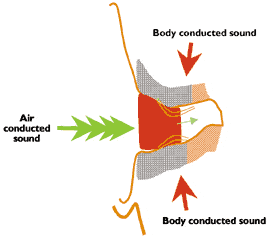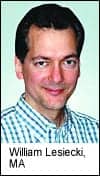The occlusion effect is the sensation of increased loudness (sound pressure level), especially in the low frequencies, a person experiences to self-generated sounds (vocalization, chewing, swallowing, walking, and the like), when the ears are covered (occluded). The occlusion effect appears to be a consequence of the transmission of this increased signal through the normal middle ear, not appearing to be present when middle ear pathology exists. The reason for the absence of an occlusion effect in middle ear losses is the inability of the middle ear system to transmit the increased SPL to the cochlea.1
Explanations for the occlusion effect have been quite varied and a number of origins (sources) have been proposed, including: Masking Theory,2-4 Outflow Theory,5 Inertial/osseotympanic Theory,6,7 and Impedance Theory.8-10 Regardless of the origin, Feldman et al.1 offer an appropriate operational explanation when they state:
…one would be hard put to assume that the occlusion effect was not a consequence of a signal generated peripheral to the tympanic cavity and that the occlusion effect is nothing more than the transmission of some of this increased SPL through the normal air-conduction pathway.1
The occlusion effect is usually described by hearing aid wearers as “it sounds like I am listening in a barrel,” “my voice sounds too loud,” “I can hear my footsteps and other body-generated sounds,” etc. This is a common complaint by wearers of hearing aids when the device or earpiece in the ear canal is not properly fit. The magnitude of the increased SPL when wearing traditional instruments terminating in the cartilaginous ear canal (as measured using probe microphone procedures) is approximately 25 dB at 250 Hz, but varies by individual. The resultant increased loudness sensation, as experienced by the wearer of hearing aids, can be reduced often by use of a large vent at least 2 mm in diameter.11 However, when venting leads to feedback, an earpiece fitted deeply into the ear canal—providing full contact with the bony canal structure—is the alternative option to reduce the occlusion effect.12-19
.gif)
Test Instrument
The current study was conducted to determine if a new style hearing instrument resulted in the desired reduction of the occlusion effect. The PAC (Post Auricular Canal) instrument, developed by Sebotek Hearing Systems, is unique in that it has a separate speaker module (ie, hearing aid receiver assembly) that fits deeply within the ear canal and makes full contact with the bony structure of the ear canal (Figure 1). The speaker module is connected by an extremely thin-gauge, translucent wire to the instrument’s sound processor module. When fit properly, the ultra soft tip surrounding the speaker module makes full contact with the bony structure of the canal, but leaves the cartilaginous region of the ear canal (suspected as contributing to the occlusion effect) open.
.gif)
Study Methods and Results
An Occlusion Effect Meter (Etymotic Research ER-33) was used to measure the magnitude (in dB) of the occlusion effect and earpiece acoustic seal (the latter assumed to be a requirement of a reduced occlusion effect if made in the bony section of the ear canal). Measurements were made at 250 Hz for 11 subjects. Results of individually-averaged occlusion effects ranged between -10 and +5 dB (Figure 2). This shows that the PAC produced little, no, or negative occlusion effect for all subjects. With an average measured occlusion effect of -3.6 dB, the results suggest that the PAC design measures less than the open ear canal, if it is assumed that the open ear canal has no occlusion effect. Hearing aids that seal in the cartilaginous canal normally result in occlusion effect measurements in the range of 20-30 dB at 250 Hz.
An occasional concern expressed with deeply fitting hearing aids relates to the potential insertion problems; traditional earmolds are often difficult to navigate comfortably past the bends of the ear canal. Because the PAC instrument is designed to be fitted deeply, subjects were allowed a self-practice session to learn how to insert the speaker assembly for acceptable sound quality when they spoke. Although the magnitude of the occlusion effect varied with practice of the PAC tip insertion, all subjects learned quickly to insert the earpiece to obtain the minimum occlusion effect.
.gif)
Figure 3 shows the individual variability of the multiple insertion process. During this training session, which was monitored, the shallower the insertion, the greater the occlusion effect (as might be expected). For Subjects 10, 3, and 8, the shallow insertions are identified with the letter “S.”
It is important to confirm that minimal Occlusion Effect Meter measurements relate to the approval of one’s own voice (sound quality/loudness), and although not evaluated systematically, subjective reports of vocal approval were in good agreement with meter readings. The PAC’s insertion depth was found to be a critical factor by the subjects.
Occlusion Effect and Seal
The cross-hatched bars in Figures 2 and 3 represent the acoustic seal as measured (in dB) using the Occlusion Effect Meter for each of the subjects. Use of the standard crescent-shaped probe tube of the Occlusion Effect Meter was replaced with a round tube sewn through the ultra soft tip for Subject 9 to provide a seal to obtain accurate measurements.
Contrary to what might be expected, the best seal did not necessarily translate to the greatest reduction in the occlusion effect, nor did the poorest seal show the greatest occlusion effect. As a result, the relationship between having a good seal and maximum reduction of the occlusion effect is not clear. However, if feedback is not an issue, a good seal may be a non-issue because the designed earpiece functioned sufficiently well to reduce the occlusion effect. Still, it appears that in all cases the speaker assembly arrangement used provided an effective acoustic seal (range from 12.5 dB-30 dB).
Summary
The new deeply fitted hearing aid with the active seal (PAC) provided maximum measured reduction of the occlusion effect from an approximate expectation of 25 dB to a mean of -3.6 dB. This objectively measured reduction was confirmed by corresponding subjective improvement comments about the quality/loudness.
While a good acoustic seal deep in the ear canal is considered essential to the reduction of the occlusion effect, the data did not show an absolute relationship between the magnitude of the seal and the magnitude of the occlusion effect reduction. The data does suggest that this style hearing aid, while developed to address a number of the continuing issues related to deep canal hearing aid technology, effectively manages at least one of the major problems well—that of the occlusion effect. Using this new hearing aid fitting tool, dispensing professionals increase their chances to better satisfy many current hearing aid purchasers and remove a leading reason hearing aids are returned for credit by prospective, first time purchasers.
Acknowledgments
Occlusion effect and seal measurements were made by Mead Killion and Gail Gudmundsen of Etymotic Research in Elk Grove Village, IL.
| Wayne J. Staab, PhD, is president of Dr. Wayne J. Staab & Associates, Dammeron Valley, Utah, and a consultant to SeboTek Hearing Systems, Tulsa, Okla, on the PAC project. He is an adjunct professor at Arizona State University and on the faculty of the Arizona School of Health Sciences. Correspondence can be addressed to Wayne J. Staab, PhD, 352 Sundial Ridge Circle, Dammeron Valley, UT 84783; email: [email protected]. More information on the PAC device can be obtained by visiting www.sebotek.com. |
References
1. Feldman AS, Grimes CT, Shur IB. Further Studies of the occlusion effect. Technical Report No. 10. Syracuse, NY: State University of New York; April 1972.
2. Pohlman AG. Correlations between the acuity for hearing and bone transmitted sounds in Renee negative and Rinne positive cases. Ann Otol Rhinol Laryngol. 1930;39:927-960.
3. Hallpike CS. Some observations on bone conduction. J Laryngol Otol. 1930;45:1-24.
4. Dean C. Audition by bone conduction. J Acoust Soc Am. 1930;2:281-296.
5. Mach E. Zur theories des gehorogans. Sitzungs B Arcad Wiss Wien Math Phys Kl Abt. 1863;2 (48):283.
6. von Békésy G. Zue theorie des horens bei der schallaufnahme durch knochenieitung. Ann d Physik. 1932;13:111.
7. Barany E. A contribution to the physiology of bone conduction. Acta Otol Laryng. 1938;Suppl. 26.
8. Huizing EH. Bone conduction: The influence of the middle ear. Acta Otolaryngol. 1960;Suppl. 151.
9. Allen GW, Fernandez C. (1960). The mechanism of bone conduction. Ann Otol Rhinol Laryngol. 1960;69: 5-28.
10. Tonndorf et al. Bone conduction: Studies in experimental animals. Acta Oto-Laryngol. 1966;Suppl. 213.
11. Revit LJ. Two techniques for dealing with the occlusion effect. Hear Instrum. 1992; 43(12),16-18.
12. Zwislocki J. Acoustic attenuation between the ears. J Acoust Soc Am. 1953; 25, 752-759.
13. Berger EH. Tips for fitting hearing protectors. Sound and Vibration. 1988;Oct: 22-25.
14. Killion MC, Wilber LA, Gudmundsen G. Zwislocki was right…a potential solution to the “hollow voice” problem (the amplified occlusion effect) with deeply sealed earmolds. Hear Instrum. 1988;39(1): 14.
15. Staab WJ. Deep canal hearing aids: A fitting rationale. American Auditory Society 16th Annual Meeting, New Orleans, LA, September, 1989.
16. Staab WJ. (1992). The peritympanic instrument: fitting rationale and test results. Hear Jour. 1992;45(10):21-26.
17. Staab WJ, Finlay B. A fitting rationale for deep canal hearing instruments. Hear Instrum. 1991;42(1): 6-10, 48.
18. Bryant MP, Mueller HG, Northern, JL. Minimal contact long canal ITE hearing instruments. Hearing Instrum. 1991;42(1): 12-15, 48.
19. XP peritympanic hearing instrument. Dispenser literature. Eindhoven, The Netherlands: Philips Hearing Instruments; 1991.

.gif)



